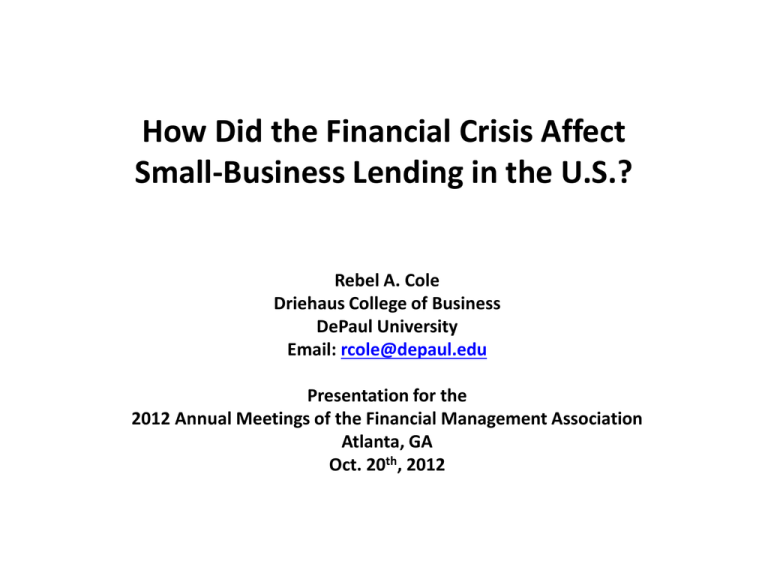How Did the Financial Crisis Affect Small
advertisement

How Did the Financial Crisis Affect Small-Business Lending in the U.S.? Rebel A. Cole Driehaus College of Business DePaul University Email: rcole@depaul.edu Presentation for the 2012 Annual Meetings of the Financial Management Association Atlanta, GA Oct. 20th, 2012 Summary • In this study, we use a panel regression model with bank- and year-fixed effects to analyze changes in U.S. bank lending to businesses, as reported by banks to their regulators. • We find that bank lending to all businesses and, in particular, to small businesses, declined precipitously following onset of the financial crisis. Summary • We also examine the relative changes in business lending by banks that did, and did not, receive TARP funds from the U.S. Treasury following onset of the crisis in 2008. • Our analysis reveals that banks receiving capital injections from the TARP failed to increase their smallbusiness lending, even though this was the primary goal of the TARP; instead, these banks decreased their lending by even more than other banks. • Additional analysis incorporating county-year fixed effects reveals that the relative declines in lending by TARP banks appear to be demand driven, but re-confirms the failure of TARP banks to increase small-business lending. Summary • Our study also provides important new evidence on the determinants of business lending. • Most importantly, we find a strong and significant positive relation between bank capital adequacy and business lending, especially small-business lending. • This new evidence refutes claims by U.S. banking industry lobbyists that higher capital standards would reduce business lending and hurt the economy. • Instead, it shows that higher capital standards would improve the availability of credit to U.S. firms, especially to small businesses. Introduction • When the U.S. residential housing bubble burst in 2007 – 2008, credit markets in the U.S. and around the world seized up. • Anecdotal evidence suggests that small businesses, which largely rely upon banks for credit, were especially hard hit by the financial crisis. • In response, the U.S. Treasury injected more than $200 billion of capital into more than 700 U.S. banking organizations to stabilize their subsidiary banks and promote lending, especially lending to small businesses. Introduction • Here, we provide the first rigorous evidence on how successful, or, more accurately, how unsuccessful the CPP turned out to be. • Our evidence points to serious failure, as smallbusiness lending by banks participating in the CPP fell by even more than at banks not receiving funds from the CPP. • In other words, TARP banks took the taxpayers’ money, but then cut back on lending by even more than banks not receiving taxpayer dollars. Introduction 2008 TARP Capital Injections Large U.S. Bank Holding Companies with $50+ Billion in Total Assets $ Billions 25.0 Percentage Change in Dollar Amount of Small-Business Lending, 2008 – 2011 Large U.S. Bank Holding Companies with $50+ Billion in Total Assets 0% 20.0 -10% 15.0 -20% 10.0 -30% 5.0 -40% 0.0 -50% -60% This is especially true for the largest banks that received the biggest capital injections. The more they got, the more they reduced small-business lending. Related Literature • The study most closely related to ours from a methodological viewpoint is Peek and Rosengren (1998), which examines the impact of bank mergers on small business lending. • Like us, they examine the change in small business lending (as measured by the ratio of small-business loans to total assets) by groups of banks subject to different “treatments.” Related Literature • Another closely related study is Berger and Udell (2004), which examines changes in bank lending to test what they call the “institutional memory” hypothesis. • . They regress the annual change in the dollar amount of business lending against a set of explanatory variables designed to measure “institutional memory” (their primary variable of interest), as well as variables designed to measure the health of the bank and overall loan demand. Related Literature • Ivashina and Scharfstein (2009) use loan-level data from DealScan to analyze changes in the market for large, syndicated bank loans. – Their focus is on whether banks more vulnerable to contagion following the failure of Lehman Brothers reduced their lending by more than other banks. • Our study is complementary to theirs: – They cover the large, syndicated loans that often are securitized and do not appear on bank balance sheets. – We cover the smaller, non-syndicated loans that are not securitized, but remain on the balance sheets of the bank lenders. Related Literature • Black and Hazelwood (2011) examine the impact of the TARP on bank lending, as we do, but from a different perspective. • Using data from the Fed’s Survey of Terms of Business lending, they analyze the risk ratings of individual commercial loans originated during the crisis. • They find that risk-taking increased at large TARP banks, but declined at small TARP banks, while lending, in general, declined. Related Literature • Duchin and Sosyura (2012) analyze the effect of the CPP on bank lending and risk-taking. – Using data on individual mortgage applications, they find that the change in mortgage originations was no different at TARP banks than at non-TARP banks with similar characteristics, but that TARP banks increased the riskiness of their lending relative to non-TARP banks. – They also finds similar results for large syndicated corporate loans. • While Duchin and Sosyura focus on residential mortgage lending, our study focuses on business lending, and, in particular, small-business lending. Data: FFIEC Call Reports • Our primary source is the FFIEC’s quarterly financial Reports of Income and Condition, or “Call Reports,” that are filed by each commercial bank in the U.S. • Beginning in 1992, the June Call Report includes a section that gathers information on small business lending. • The schedule collects information on the number and amount outstanding of loans secured by nonfarm nonresidential properties and commercial & industrial loans with original loan amounts of less than $1 Million. Data: FDIC Institution Directory • It is important to account for the effect of mergers in calculating changes in bank balance-sheet data over time. • During our 1994 – 2011 sample period, more than 9,000 banks disappeared via mergers. • To account for the impact of mergers on the balance sheet, of acquiring banks, we identify the acquirer and target, as well as the date of each acquisition, using information from the FDIC’s Institution Directory, and aggregate data from acquirer and target for the pre-merger period. Data: TARP Capital Purchase Program • Our third source of data for information on the Troubled Asset Relief Program (“TARP”) is the website of the U.S. Treasury, where we obtain information on which banks participated in the Capital Purchase Program (“CPP”). • One of the stated goals of the CPP was to encourage lending to small businesses. Data: TARP Capital Purchase Program • We identify 743 transactions totaling to $205 billion in capital injections during the period from Oct. 28, 2008 through Dec. 31, 2009. • We eliminate multiple transactions, and OTSregulated thrifts. • We then match holding companies with subsidiary banks from June 2009, resulting in our final sample of 851 TARP banks. Methodology • We utilize a fixed-effects regression model that exploits the panel nature of our dataset to explain three different measures of small-business lending: – (1) the year-over-year percentage change in the dollar value of small-business loans (as measured by Berger and Udell (2004)); – (2) the year-over-year change in the ratio of smallbusiness loans to total assets (as measured by Peek and Rosengren (1998)); and – (3) the natural logarithm of the dollar value of smallbusiness loans. Methodology: Fixed-Effects Panel Regression • Our general model takes the form: SBL i, t = β 0 + β 1 × Crisis × TARP i, t - 1 + β 2 × Controls i, t - 1 + є i, t • where: – SBL i, t is one of our three measures of small-business lending – TARP is a dummy variable indicating CPP banks – Crisis is a set of post-crisis year dummy variables – Controls is a set of bank control variables. Methodology: Control Variables • • • • • • • • Equity to Assets NPLs to Assets Earnings to Assets Liquid Assets to Assets Core Deposits to Assets Loan Commitments to Assets plus Commitments Bank Size (log of Assets) De Novo dummy (less than 5 years in operation) Results: Total Business Lending and Small Business Lending 2001 - 2011 Commercial Bank Loans 2001 – 2011 Small-Business Loans 2001 – 2011 700 2,500 600 2,000 500 400 $ Billions $ Billions 1,500 1,000 300 200 500 100 0 0 Total Bus Loans C&I Loans CRE Loans Total SB Loans SB C&I Loans SB CRE Loans Results: Total Small Business Lending TARP Banks vs. Non-TARP Banks 1994 - 2011 700 600 $Billions 500 400 300 200 100 0 All Banks Non-TARP TARP Small-business lending declined much more at TARP than at non-TARP banks. Results: Change in Dollar Amount of Lending Panel Regressions with Year, Bank and County Fixed-Effects Small Bus. Lending Variables Coef. TARP Indicators TARP2009 TARP2010 TARP2011 -0.008 -0.010 0.007 County Fixed Effects Year Fixed Effects Bank Fixed Effects Observations R-squared Number of Banks Yes Yes Yes 140,253 0.178 13,239 t-Stat. -0.7 -0.8 0.6 Small CRE Lending Small C&I Lending Coef. 0.000 0.008 0.029 Yes Yes Yes 140,252 0.131 13,239 Coef. t-Stat. 0.0 0.6 1.9 * -0.017 0.000 -0.007 t-Stat. -1.3 0.0 -0.5 Yes Yes Yes 140,253 0.134 13,239 There are no significant differences in the change in small-business lending by TARP and non-TARP banks, after controlling for county-fixed effects. Results: Change in Dollar Amount of Lending Panel Regressions with Year, Bank and County Fixed-Effects Small Bus. Lending Small C&I Lending Small CRE Lending Variables Bank Controls Loans Total Equity NPLs Net Income Liquid Assets Core Deposits Commitments Bank Size De Novo Observations R-squared Number of Banks Coef. t-Stat. -1.537 0.347 -1.624 -0.147 -0.044 -0.040 0.349 -0.118 0.157 140,253 0.178 13,239 -55.6 11.2 -14.5 -2.5 -3.0 -2.4 7.3 -33.9 25.2 *** *** *** ** *** ** *** *** *** Coef. t-Stat. -2.475 0.390 -1.846 -0.133 0.026 -0.100 0.317 -0.109 0.150 140,252 0.131 13,239 -37.1 11.1 -13.5 -2.5 1.5 -5.1 5.3 -26.2 19.9 *** *** *** ** *** *** *** *** Coef. t-Stat. -2.784 0.277 -1.325 -0.110 -0.073 -0.037 0.236 -0.110 0.131 140,253 0.134 13,239 -64.0 8.8 -11.5 -2.2 -4.4 -1.9 5.5 -29.5 18.8 Banks with higher ratios of capital to assets increase lending by more than banks with lower capital ratios. *** *** *** ** *** * *** *** *** Results: Change in Dollar Amount of Lending Panel Regressions with Year, Bank and County Fixed-Effects Small Bus. Lending Small C&I Lending Small CRE Lending Variables Bank Controls Loans Total Equity NPLs Net Income Liquid Assets Core Deposits Commitments Bank Size De Novo Observations R-squared Number of Banks Coef. t-Stat. -1.537 0.347 -1.624 -0.147 -0.044 -0.040 0.349 -0.118 0.157 140,253 0.178 13,239 -55.6 11.2 -14.5 -2.5 -3.0 -2.4 7.3 -33.9 25.2 *** *** *** ** *** ** *** *** *** Coef. t-Stat. -2.475 0.390 -1.846 -0.133 0.026 -0.100 0.317 -0.109 0.150 140,252 0.131 13,239 -37.1 11.1 -13.5 -2.5 1.5 -5.1 5.3 -26.2 19.9 *** *** *** ** *** *** *** *** Coef. t-Stat. -2.784 0.277 -1.325 -0.110 -0.073 -0.037 0.236 -0.110 0.131 140,253 0.134 13,239 -64.0 8.8 -11.5 -2.2 -4.4 -1.9 5.5 -29.5 18.8 Banks with higher ratios of NPLs to assets increase lending by more than banks with lower ratios of NPLs to assets. *** *** *** ** *** * *** *** *** Results: Change in Dollar Amount of Lending Panel Regressions with Year, Bank and County Fixed-Effects Small Bus. Lending Small C&I Lending Small CRE Lending Variables Bank Controls Loans Total Equity NPLs Net Income Liquid Assets Core Deposits Commitments Bank Size De Novo Observations R-squared Number of Banks Coef. t-Stat. -1.537 0.347 -1.624 -0.147 -0.044 -0.040 0.349 -0.118 0.157 140,253 0.178 13,239 -55.6 11.2 -14.5 -2.5 -3.0 -2.4 7.3 -33.9 25.2 *** *** *** ** *** ** *** *** *** Coef. t-Stat. -2.475 0.390 -1.846 -0.133 0.026 -0.100 0.317 -0.109 0.150 140,252 0.131 13,239 -37.1 11.1 -13.5 -2.5 1.5 -5.1 5.3 -26.2 19.9 *** *** *** ** *** *** *** *** Coef. t-Stat. -2.784 0.277 -1.325 -0.110 -0.073 -0.037 0.236 -0.110 0.131 140,253 0.134 13,239 -64.0 8.8 -11.5 -2.2 -4.4 -1.9 5.5 -29.5 18.8 *** *** *** ** *** * *** *** *** Banks with higher ratios of net income to assets increase lending by less than banks with lower ratios of net income to assets. Results: Change in Dollar Amount of Lending Panel Regressions with Year, Bank and County Fixed-Effects Small Bus. Lending Small C&I Lending Small CRE Lending Variables Bank Controls Loans Total Equity NPLs Net Income Liquid Assets Core Deposits Commitments Bank Size De Novo Observations R-squared Number of Banks Coef. t-Stat. -1.537 0.347 -1.624 -0.147 -0.044 -0.040 0.349 -0.118 0.157 140,253 0.178 13,239 -55.6 11.2 -14.5 -2.5 -3.0 -2.4 7.3 -33.9 25.2 *** *** *** ** *** ** *** *** *** Coef. t-Stat. -2.475 0.390 -1.846 -0.133 0.026 -0.100 0.317 -0.109 0.150 140,252 0.131 13,239 -37.1 11.1 -13.5 -2.5 1.5 -5.1 5.3 -26.2 19.9 *** *** *** ** *** *** *** *** Larger banks increase lending by less than smaller banks. Coef. t-Stat. -2.784 0.277 -1.325 -0.110 -0.073 -0.037 0.236 -0.110 0.131 140,253 0.134 13,239 -64.0 8.8 -11.5 -2.2 -4.4 -1.9 5.5 -29.5 18.8 *** *** *** ** *** * *** *** *** Results: Change in Dollar Amount of Lending Panel Regressions with Year, Bank and County Fixed-Effects Small Bus. Lending Small C&I Lending Small CRE Lending Variables Bank Controls Loans Total Equity NPLs Net Income Liquid Assets Core Deposits Commitments Bank Size De Novo Observations R-squared Number of Banks Coef. t-Stat. -1.537 0.347 -1.624 -0.147 -0.044 -0.040 0.349 -0.118 0.157 140,253 0.178 13,239 -55.6 11.2 -14.5 -2.5 -3.0 -2.4 7.3 -33.9 25.2 *** *** *** ** *** ** *** *** *** Coef. t-Stat. -2.475 0.390 -1.846 -0.133 0.026 -0.100 0.317 -0.109 0.150 140,252 0.131 13,239 -37.1 11.1 -13.5 -2.5 1.5 -5.1 5.3 -26.2 19.9 *** *** *** ** *** *** *** *** De Novo banks increase lending by more than older banks. Coef. t-Stat. -2.784 0.277 -1.325 -0.110 -0.073 -0.037 0.236 -0.110 0.131 140,253 0.134 13,239 -64.0 8.8 -11.5 -2.2 -4.4 -1.9 5.5 -29.5 18.8 *** *** *** ** *** * *** *** *** Results: Other Dependent Variables • Results for Change in Loan to Asset Ratio and for log of Loan Amount are qualitatively similar to results for Change in Loan Amount. • Results for Total Business Lending also are qualitatively similar. Conclusions • In this study, we analyze how the financial crisis of 2007 – 2008 and its aftermath affected U.S. bank lending to businesses and, in particular, lending to small-businesses. • We find that bank lending to businesses in the U.S. declined significantly following the crisis, and that it declined by significantly more for small firms than for larger firms. • These results hold in both univariate and multivariate analyses. Conclusions • We also find that banks receiving capital injections from the TARP’s $200 billion Capital Purchase Program decreased their lending to businesses both large and small by even more than did banks not receiving government capital. • One of the key goals of the TARP was to boost business lending, especially to small businesses. • In this respect, our results show that the TARP was a failure. Conclusions • Our analysis also reveals some other interesting results unrelated to lending during the crisis, but that provide important new evidence on the determinants of business lending. • Most importantly, we find a strong and significant positive relation between bank capital adequacy and business lending. • This has important policy implications for regulators who are considering proposals to increase minimum capital requirements, especially for systemically important institutions. • Our results suggest that higher capital requirements will lead to more business lending rather than less business lending, as the U.S. banking lobby has claimed.




